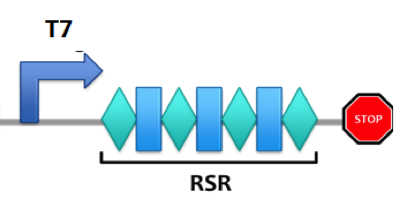Part:BBa_K786031:Design
T7promoter-RSR-T7teminator
- 10COMPATIBLE WITH RFC[10]
- 12COMPATIBLE WITH RFC[12]
- 21COMPATIBLE WITH RFC[21]
- 23COMPATIBLE WITH RFC[23]
- 25INCOMPATIBLE WITH RFC[25]Illegal NgoMIV site found at 816
- 1000COMPATIBLE WITH RFC[1000]
Biobrick design
Our biobrick is designed to be an integration of two parts, the protein part and the R-S-R part. Sequences of proteins Cas3 and cascade complex subunits are located in the upstream of the RSR system.
The number of the repeat and spacer are not fixed and the distance from the promoter does not affect the functionality.
The protein part in the biobrick is not essential for the system to work, as the type I-E CRISPR/Cas system is an endogenous system in E. coli. Since this part is designed to improve the sufficiency of system functionality, we choose to use Pveg, a strong constitutive promoter. This choice also makes it possible to utilize this system in other microorganisms where CRISPR system does not exist naturally, such as Bacillus subtilis.
To improve the efficiency for construction, we split them into two biobricks containing Cas3 and the R-S-R part, and synthesize them separately Therefore, when testing the system in E. coli, transformation of the R-S-R biobrick alone is enough for characterization.
(a) ‘Repeat’ design
A palindrome can be observed by studying some samples of repeat sequences of CRISPR system of E. coli. The secondary structure of pre-crRNA shows that the base pairing helps to form a loop, which may contribute to the Cas3 and Cascade in expression and interference stages of type-I CRISPR system.
From related research papers [2, 3], we obtained several repeat sequences of E. coli strain K-12. Although repeat sequences from different sources may not be exactly identical, similar characteristics can be found.
We also tried other tools for repeat design. An online CRISPR database CRISPRdb (http://crispr.u-psud.fr/) as recommended by 2011 USC iGEM team provides repeat consensus of different strains [4].
(b) Spacer Design
PAM (Proto-spacer Adjacent Motif) is located adjacent to the proto-spacer, upstream for a sense strand or downstream for an antisense strand. This 3-bp motif is essential for the proto-spacer recognition by Cascade complex. In E. coli, Cascade tolerates at least four PAMs, CTT, CAT, CTC and CCT in an antisense strand [5].
Seed sequence, as indicated in the graph, is another essential for spacer design. Mutants on seed sequence may lead to “escape”. Thus for these 7 base pairs, the crRNA must complement to the target DNA. In our design, we have the whole spacer to be completely complementary to the protospacer, so does the crRNA. Therefore, the problem of "escape" due to the mismatch in seed sequence is not crucial.
The designed length of spacer in our CRISPR system should be 32bp. The spacer is specially desigened to target on the genomic DNA of a typical strain of E. coli, K12 MG1655. It is a non-coding DNA sequence since it is important to confirm that the factor causing the death of E. coli is due to the cleavage of its genomic DNA but not the malfunction of the gene being targeted, so a non-coding DNA sequence is preferred than a coding DNA sequence. The selection of the non-coding DNA sequence of E. coli K12 MG1655 is random, and the 32 bp is taken from 121595-121626 (GenBank: U00096.2 )
Source
The 'repeat' sequence in CRISPR/cas system of E.coli strain K12.
References
[1] Makarova KS, Haft DH, Barrangou R, et al. (2011). Evolution and classification of the CRISPR-Cas systems. Nat Rev Microbiol. 9: 467-477.
[2] Brouns SJ, Jore MM, Lundgren M, et al. (2008). Small CRISPR RNAs guide antiviral defense in prokaryotes. Science. 321: 960-964.
[3] Yosef I, Goren MG, Qimron U (2012). Proteins and DNA elements essential for the CRISPR adaptation process in Escherichia coli. Nucleic Acids Res. 40: 5569-5576.
[4] Grissa I, Vergnaud G, Pourcel C (2007). The CRISPRdb database and tools to display CRISPRs and to generate dictionaries of spacers and repeats. BMC Bioinformatics. 8: 172.
[5] Semenova E, Jore MM, Datsenko KA, et al. (2011). Interference by clustered regularly interspaced short palindromic repeat (CRISPR) RNA is governed by a seed sequence. Proc Natl Acad Sci U S A. 108: 10098-10103.
[6] Westra ER, van Erp PB, Kunne T, et al. (2012). CRISPR immunity relies on the consecutive binding and degradation of negatively supercoiled invader DNA by Cascade and Cas3. Mol Cell. 46: 595-605.




